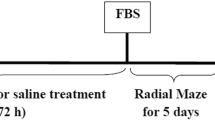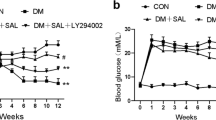Abstract
Hippocampal neuronal apoptosis accompanied by impairment of cognitive function occurs in primary diabetic encephalopathy. In this study, we investigated the neuroprotective mechanism of the iridoid glycoside, aucubin, using rats (n=8). Diabetes mellitus was induced in the rats by intraperitoneal (i.p.) injection of streptozotocin (60 mg/kg body weight). After 65 d, half of the DM rats were administered aucubin (5 mg/kg; i.p.) for 15 d, yielding treatment DM+A. A third group of rats received no streptozotocin or aucibin, and served as controls (CON). Encephalopathy was assessed using Y-maze behavioral testing. Rats were euthanized on Day 87, and hippocampi were excised for visual (light and transmission electron microscopic) and immunochemical (Western blot; immunohistochemical) assessments of the CA1 subfield for apoptosis and expression of regulatory proteins Bcl-2 and Bax. Treatment responses to all the parameters examined (body weight, plasma glucose, Y-maze error rates, pyramidal cell ultrastructure, proportions of apoptotic cells, levels of expression of Bcl-2 and Bax, and survivability of neuronal cells) were identical: there were highly significant differences between DM and CON groups (P<0.001), but the effects were significantly moderated (P<0.01) in DM+A compared with DM. These findings confirm the association of apoptosis with the encephalopathic effects of diabetes mellitus, and suggest a major role of the expression levels of Bcl-2 and Bax in the regulation of apoptotic cell death. All of the results suggest that aucubin could effectively inhibit apoptosis by modulating the expressions of Bcl-2 and Bax genes.
Similar content being viewed by others
References
Kramer L, Fasching P, Madl C, et al. Previous episodes of hypoglycemic coma are not associated with permanent cognitive brain dysfunction in IDDM patients on intensive insulin treatment. Diabetes, 1998, 47: 1909–1914, 9836523, 10.2337/diabetes.47.12.1909, 1:CAS:528:DyaK1cXnvVCru78%3D
Li Z G, Zhang W X, Sima A A F. The role of impaired insulin/IGF action in primary diabetic encephalopathy. Brain Res, 2005, 1037: 12–24, 15777748, 10.1016/j.brainres.2004.11.063, 1:CAS:528:DC%2BD2MXitleqsb0%3D
Lin Y H, Westenbroek C, Tie L, et al. Effects of glucose, insulin, and supernatant from pancreatic beta-cells on brain-pancreas relative protein in rat hippocampus. Neurochem Res, 2006, 31(12): 1417–1424, 17091403, 10.1007/s11064-006-9193-9, 1:CAS:528:DC%2BD28Xht1OhtrfE
Uberall M A, Renner C, Edl S, et al. VEP and ERP abnormalities in children and adolescents with prepubertal onset of insulin-dependent diabetes mellitus. Neuropediatrics, 1996, 27: 88–93, 8737824, 10.1055/s-2007-973755, 1:STN:280:DyaK28zlsVejtQ%3D%3D
Li Z G, Zhang W, Grunberger G, et al. Hippocampal neuronal apoptosis in type 1 diabetes. Brain Res, 2002, 946: 221–231, 12137925, 10.1016/S0006-8993(02)02887-1, 1:CAS:528:DC%2BD38Xls1ans7g%3D
Trudeau F, Gagnon S, Massicotte G. Hippocampal synaptic plasticity and glutamate receptor regulation: influences of diabetes mellitus. Eur J Pharmacol, 2004, 490: 177–186, 15094084, 10.1016/j.ejphar.2004.02.055, 1:CAS:528:DC%2BD2cXjt1Shtr8%3D
Perouansky M. General anesthetics and long-term neurotoxicity. Handb Exp Pharmacol, 2008, 182: 143–157, 18175090, 10.1007/978-3-540-74806-9_7, 1:CAS:528:DC%2BD1cXjtVOls74%3D
Lossi L, Gambino G. Apoptosis of the cerebellar neurons. Histol Histopathol, 2008, 23(3): 367–380, 18072093
Rizk N N, Myatt-Jones J, Rafols J, et al. Insulin like growth factor-1 (IGF-1) decreases ischemia-reperfusion induced apoptosis and necrosis in diabetic rats. Endocrine, 2007, 31(1): 66–71, 17709900, 10.1007/s12020-007-0012-0, 1:CAS:528:DC%2BD2sXotlCitbY%3D
Thompson C B. Apoptosis in the pathogenesis and treatment of disease. Science, 1995, 267: 1456–1462, 7878464, 10.1126/science.7878464, 1:CAS:528:DyaK2MXktlClt70%3D
Saravia F E, Beauquis J, Revsin Y, et al. Hippocampal neuropathology of diabetes mellitus is relieved by estrogen treatment. Cell Mol Neurobiol, 2006, 26: 943–957, 16807785, 10.1007/s10571-006-9096-y, 1:CAS:528:DC%2BD28Xhtleksb3L
An S J, Pae H O, Oh G S, et al. Inhibition of TNF-a, IL-1 h, and IL-6 productions and NF-kB activation in lipopolysaccharide-activated RAW 264.7 macrophages by catalposide, an iridoid glycoside isolated from Catalpa ovata G. Don (Bignoniaceae). Int Immunopharmacol, 2002, 2: 1173–1181, 12349954, 10.1016/S1567-5769(02)00085-1, 1:CAS:528:DC%2BD38Xmtlehsrw%3D
Li Z G, Sima A A F. C-peptide and central nervous system complications in diabetes. Exp Diabesity Res, 2004, 5: 79–90, 15198373, 10.1080/15438600490424550, 1:CAS:528:DC%2BD2MXis1Slsbw%3D
Schoenle E J, Schoenle D, Molinari L, et al. Impaired intellectual development in children with Type I diabetes: Association with HbA(1c), age at diagnosis and sex. Diabetologia, 2002, 45: 108–114, 11845229, 10.1007/s125-002-8250-6, 1:CAS:528:DC%2BD38Xitl2js7s%3D
Sima A A F, Kamiya H, Li Z G. C-peptide, hyperglycemia, and central nervous system complications in diabetes. Eur J Pharmacol, 2004, 490: 187–197, 15094085, 10.1016/j.ejphar.2004.02.056, 1:CAS:528:DC%2BD2cXjt1Shtrw%3D
Scorrano L, Korsmeyer S J. Mechanisms of cytochrome c release by proapoptotic BCL-2 family members. Biochem. Biophys Res Commun, 2003, 304: 437–444, 12729577, 10.1016/S0006-291X(03)00615-6, 1:CAS:528:DC%2BD3sXjt1Kisrw%3D
Budinger G R, Tso M, McClintock D S, et al. Hyperoxia-induced apoptosis does not require mitochondrial reactive oxygen species and is regulated by Bcl-2 proteins. J Biol Chem, 2002, 277: 15654–15660, 11877388, 10.1074/jbc.M109317200, 1:CAS:528:DC%2BD38Xjs1Wjs70%3D
Gross A, McDonnell J M, Korsmeyer S J. BCL-2 family members and the mitochondria in apoptosis. Genes Dev, 1999, 13: 1899–1911, 10444588, 10.1101/gad.13.15.1899, 1:CAS:528:DyaK1MXltlGktrg%3D
Kelekar A, Thompson C B. Bcl-2-family proteins: the role of the BH3 domain in apoptosis. Trends Cell Biol, 1998, 8: 324–330, 9704409, 10.1016/S0962-8924(98)01321-X, 1:CAS:528:DyaK1cXltlehurY%3D
Bernini R, Iavarone C, Trogolo C. 1-O-β-D-glucopyranosyleucommiol, an iridoid glucoside from Aucuba japonica. Phytochem, 1984, 23: 1431–1433, 10.1016/S0031-9422(00)80480-X, 1:CAS:528:DyaL2MXkt1yhsA%3D%3D
Bianco A, Iavarone C, Trogolo C. Structure of eucommiol, a new cyclopentenoid-tetraol from Eucommia ulmoides. Tetrahedron, 1974, 30: 4117–4121, 10.1016/S0040-4020(01)97394-6, 1:CAS:528:DyaE2MXhsFGnt7c%3D
Paxinos G, Watson C. The Rat Brain in Stereotaxic Coordinates. Sydney: Academic Press, 1982
Suomi J, Sirén H, Wiedmer K W S K, et al. Isolation of aucubin and catalpol from Melitaea cinxia larvae and quantification by micellar electrokinetic capillary chromatography. Anal Chim Acta, 2001, 429: 91–99, 10.1016/S0003-2670(00)01266-6, 1:CAS:528:DC%2BD3MXkslGgtg%3D%3D
Recio M C, Giner R M, Manez S, et al. Structural considerations on the iridoids as anti-inflammatory agents. Planta Med, 1994, 60: 232–234, 8073089, 10.1055/s-2006-959465, 1:STN:280:DyaK2czltlShtQ%3D%3D
Kelliher K R, Baum M J. Nares occlusion eliminates heterosexual partner selectionwithout disrupting coitus in ferrets of both sexes. J Neurosci, 2001, 21: 5832–5840, 11466455, 1:CAS:528:DC%2BD3MXlsV2gtb8%3D
Maeda C Y, Fernandes T G, Timm H B, et al. Autonomic dysfunction in short-term experimental diabetes. Hypertension, 1995, 26: 1100–1104, 7498976, 1:STN:280:DyaK28%2FovVyqtw%3D%3D
Barber A J, Lieth E, Khin S A, et al. Neural apoptosis in the retina during experimental and human diabetes, Early onset and effect of insulin. J Clin Invest, 1998, 102: 783–791, 9710447, 10.1172/JCI2425, 1:CAS:528:DyaK1cXlsFaqsrg%3D
Carson D A, Ribeiro J M. Apoptosis and disease. Lancet, 1993, 341: 1251–1254, 8098400, 10.1016/0140-6736(93)91154-E, 1:STN:280:DyaK3s3mtFSqsQ%3D%3D
Arroba A I, Lechuga-Sancho A M, Frago L M, et al. Cell-specific expression of X-linked inhibitor of apoptosis in the anterior pituitary of streptozotocin-induced diabetic rats. J Endocrinol, 2007, 192(1): 215–227, 17210759, 10.1677/joe.1.06985, 1:CAS:528:DC%2BD2sXktlKqur0%3D
Aszalós Z. Cerebral complications of diabetes mellitus. Orv Hetil, 2007, 148(50): 2371–2376, 18055361, 10.1556/OH.2007.28221
Stefanis L, Burke R E, Greene L A. Apoptosis in neurodegenerative disorders. Curr Opin Neurol, 1997, 10: 299–305, 9266153, 10.1097/00019052-199708000-00004, 1:STN:280:DyaK2svhtFWlsg%3D%3D
Li Z G, Zhang W, Sima A A F. C-peptide enhances insulin-mediated cell growth and protection against high glucose induced apoptosis in SH-SY5Y cells. Diabetes Metab Res Rev, 2003, 19: 375–385, 12951645, 10.1002/dmrr.389, 1:CAS:528:DC%2BD3sXotl2ltLw%3D
Ainge J A, Tamosiunaite M, Woergoetter F, et al. Hippocampal CA1 place cells encode intended destination on a maze with multiple choice points. J Neurosci, 2007, 27(36): 9769–9779, 17804637, 10.1523/JNEUROSCI.2011-07.2007, 1:CAS:528:DC%2BD2sXhtVKlsrzO
González-Burgos I, Letechipía-Vallejo G, López-Loeza E, et al. Long-term study of dendritic spines from hippocampal CA1 pyramidal cells, after neuroprotective melatonin treatment following global cerebral ischemia in rats. Neurosci Lett, 2007, 423(2): 162–166, 17706355, 10.1016/j.neulet.2007.06.050, 1:CAS:528:DC%2BD2sXpt1Shsb8%3D
Thomas B F, Gilliam A F, Burch D F, et al. Comparative receptor binding analyses of cannabinoid agonists and antagonists. J Pharmacol Exp Ther, 1998, 285: 285–292, 9536023, 1:CAS:528:DyaK1cXisVCqsLY%3D
Author information
Authors and Affiliations
Corresponding author
Additional information
Support by the National Natural Science Foundation of China (Grant No. 30371053), the National Outstanding Youth Foundation of China (Grant No. 30125034), and the Scientific and Technological Plan Project of Dalian City (Grant No. 2003B3NS024)
Rights and permissions
About this article
Cite this article
Xue, H., Jin, L., Jin, L. et al. Neuroprotection of aucubin in primary diabetic encephalopathy. SCI CHINA SER C 51, 495–502 (2008). https://doi.org/10.1007/s11427-008-0069-x
Received:
Accepted:
Published:
Issue Date:
DOI: https://doi.org/10.1007/s11427-008-0069-x




